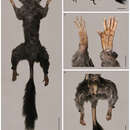Biology
provided by Arkive
Despite being discovered over one hundred years ago (6), the flightless scaly-tailed squirrel is the least known of all the Anomaluridae species (1), a group that is poorly known because of the remote area they inhabit. All other Anomalures are nocturnal (5), but some believe that the flightless scaly-tailed squirrel may actually be diurnal (4) (6). It is thought to have a vegetarian diet (4), and rest in hollow trees (6). Like other Anomalures, it may give birth to two litters of one to three young each year (4) (5). Anomaluridae young are well-developed at birth, with open eyes and thick fur, and grow fast as they are suckled by the mother. The young are weaned on chewed food stored in the parent's cheek pouches (2).
Conservation
provided by Arkive
There are no known conservation measures currently in place for the flightless scaly-tailed squirrel. Further information on population numbers, distribution, and ecology is required to enable this species' status to be determined.
Description
provided by Arkive
Superficially resembling a large dormouse, the flightless scaly-tailed squirrel is actually related to a group of African gliding rodents. Unlike its relatives, (other species belonging to the Anomaluridae family), the flightless scaly-tailed squirrel does not possess a cape-like membrane stretched between the four limbs that enables them to glide from the trees (2), hence the 'flightless' part of this species' common name. The other part of its name refers to the 13 scales on the underside of the tail near the base (4). These sharply-tipped scales enable the squirrel to hang from vertical surfaces with minimum strain on its claws (2), and also provides extra grip while climbing trees (5). The flightless scaly-tailed squirrel has soft and dense fur, which is ashy grey on the upperparts of the head, body and base of the tail, with ochre tints on the forearm, lower shin and cheeks. The underparts are pale grey, almost silvery, and the rest of the bushy tail is black (2) (4). Numerous long, shiny, black whiskers project from around the nose (4), and the narrow hands and feet bear strong bat-like claws (2). Around the ankles of the hindfeet are glandular swellings, from which arise stiff, hollow, slightly flattened and curved hairs (4). The exact function of these glandular areas is not yet known (2).
Habitat
provided by Arkive
The flightless scaly-tailed squirrel is a tree-dwelling species that inhabits tropical forest. Scaly-tails have been seen moving among low level vines, but they may also inhabit the under-storey and canopy (2).
Range
provided by Arkive
Occurs from southern Cameroon and south-western Central African Republic to northern Gabon (6). It has also been recorded on Bioko Island, part of Equatorial Guinea, situated in the Gulf of Guinea (7).
Status
provided by Arkive
Classified as Data Deficient (DD) on the IUCN Red List (1).
Threats
provided by Arkive
The extremely rare flightless scaly-tailed squirrel is known from only a few specimens, and thus there is insufficient information on its population numbers and distribution to determine how threatened this species may be (1) (4). However, their dependence on forest habitat suggests that their survival is intrinsically linked to the fate of the mature tropical forests of Central Africa (5). Unfortunately, Central Africa has already lost around 41 percent of its original forest cover, and the remaining forest continues to be threatened. For example, industrial logging is expanding rapidly in Gabon, with, (as of 2005), nearly half of the country's forest in timber leases. Logging itself has severe impacts on forests but the most significant effects are indirect, as logging access roads open up previously remote areas to hunters and slash-and-burn farmers (8). This is likely to threaten the survival of the flightless scaly-tailed squirrel and other forest inhabitants.

